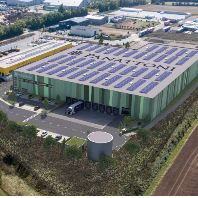European logistics occupancy costs are expected to increase 1.6% on average per year until 2014, in line with the European economic recovery, according to a new report from DTZ Research. The growth in occupancy costs will be weak until 2012, presenting significant pockets of opportunity for occupiers seeking value, before a period of steady growth up to 2014.
The first ever DTZ European Occupancy Costs Survey Logistics 2010, also reveals a considerable divergence in occupancy costs across the region, ranging from a low of 51.2 per m² per annum in Marseille to 215 per m² per annum at London Heathrow. The European average stood at 86.3 per m² per annum at the end of September 2010. Occupiers face the greatest costs in London Heathrow, Oslo, South East England and Dublin. In contrast, logistics companies benefit from lower costs in France, Belgium and Central Eastern Europe markets predominantly due to lower rental rates.
According to the report, during the next three years occupancy costs are likely to experience the largest increase in markets affected most during the economic crisis, such as Barcelona and Madrid. However, occupancy costs in these markets at the end of the forecast period (2014) will still be substantially below their pre-crisis levels. In contrast, occupiers will continue to benefit from low costs in Bucharest projected to see the lowest growth in occupancy costs until 2014.
Rob Hall, Head of DTZ CEMEA Logistics, comments: "Our research highlights the huge disparity in logistics occupancy costs across Europe when taking into consideration rental costs, property taxation and service charge differentials. Occupancy costs in the Nordic cities of Oslo, Helsinki and Stockholm are above average because of high construction costs in the cold climate and limited supply of Grade A buildings. This is in contrast to France and Belgium and the cities of Bucharest, Budapest and Prague. Our report also compares other significant business costs such as salaries and the price of diesel across the region. Our analysis reveals that some of the more expensive locations in terms of occupancy costs, offer relatively competitive labour costs a further consideration for logistics occupiers seeking to obtain maximum value from European locations."
The report shows that during the past 12 months, occupier activity in the logistics sector has improved with some demand returning, particularly for modern flexible distribution space. The rise in occupancy costs will, however, be gradual and occupiers will be able to take advantage of this period of weak growth to find good value opportunities. The expansion of trade and logistics in Central and Eastern Europe is likely to lead to increased occupier costs in Prague, whilst Hamburg is the fastest growing German hub.
Magali Marton, Head of DTZ CEMEA Research, said, "The economic outlook for European logistics is relatively positive with growth in transport and logistics predicted to outpace GDP over the next three years. This follows the sharp decline in trade witnessed in 2009. Core markets will continue to offer good value for occupiers as despite the forecast growth this is expected to be at a subdued rate. Rents in these markets tend to increase slowly due to the relative ease of supplying new space to take up the new demand."
Source: DTZ













